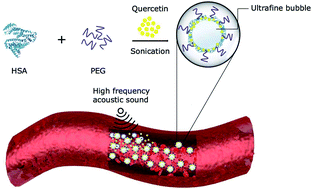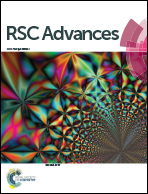Utilizing polymer-conjugate albumin-based ultrafine gas bubbles in combination with ultra-high frequency radiations in drug transportation and delivery†
Abstract
The application of ultrafine bubbles as drug carriers in drug delivery is still in its developmental stage; it is important to obtain a thorough understanding of the factors affecting the formation and stability of drug carrier matrices. In this study, the polyethylene glycol (PEG)-conjugated human serum albumin (HSA)-based ultrafine bubble simulating the physiological electrolyte concentration in human blood (154 mM) for quercetin delivery was investigated. Optical absorbance measurements, surface tension measurements, and fluorescence laser imaging were also employed to assess the plausibility of polymer-conjugated albumin-stabilized ultrafine bubbles in drug loading and drug release. The incorporation of PEG/HSA into the system illustrated a significant enhancement in the matrix's stability as confirmed by surface tension measurements and drug-loading efficiency achieving approximately 90%. In addition, in vitro drug release was performed by the application of high-frequency ultrasound, indicating more than 40% of the loaded quercetin was astonishingly liberated within 5 minutes of exposure.



 Please wait while we load your content...
Please wait while we load your content...